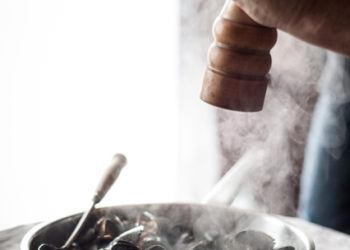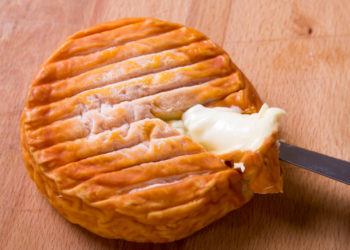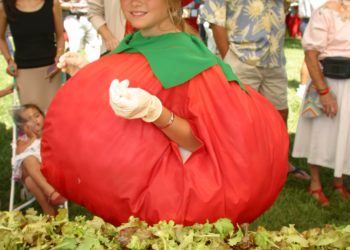My sole memories of food until my fourth birthday have to do with watermelon, which was the only thing I remember wanting to eat. Then we went on a vacation, my first ever, and celebrated my fourth birthday during a thunderstorm in Tulsa, Oklahoma, at my Aunt Ida and Uncle Roy’s house, two people I never got to know very well because they didn’t have and didn’t like children. I can still see Uncle Roy, waddling through doorways with his enormous girth shaking, surrounded by the smell of the cigar that was always in his mouth.
He had a parakeet with a colorful backroom vocabulary, and if he were still alive, no doubt Roy’s name would come up frequently in banking scandals.
After Tulsa, we journeyed north to Chicago, where the thunderstorms were even more dramatic, and eventually made our way back to San Francisco on the train, the California Zephyr. It was during that journey that my culinary future began to take shape, and I still have the children’s menu that I saved for my scrapbook. It’s an amazing document. Prices for children’s dinners, served only to “Little Boys and Girls,” the menu reads, ranged from 50 to 90 cents, prices I associate more with my mother’s day than mine. Regardless, 50 cents would get the hungry little one a bowl of milk with crackers, cinnamon toast, and cocoa. Ninety cents brought a cup of soup, a tender steak, french fries, a fresh vegetable, bread and butter, ice cream, fruit or pudding, and milk or cocoa. Ice cream sundaes were 20 cents and a peanut butter and jelly sandwich a quarter.
I don’t remember anything I may have eaten from this charming little menu, but I do recall one particular meal with stark clarity.
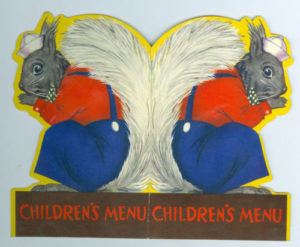
Separate children’s menus, die-cut and typically adorned with animal drawings, were common in the US in the 1900s.
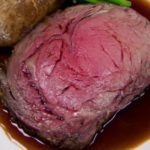
I did not inherit my mother’s distaste for rare meat; rather, I reveled in it from my earliest years.
I was asleep on my mother’s lap when dinner arrived, and awakened to her complaints about her meal. She had definitely ordered her prime rib very well done, she was saying to my older sister, and here it was blood red and dripping. Should she send it back? She certainly couldn’t eat it. I can’t imagine what went through her poor head when her tiny little daughter arose from her nap like some little Draculette and proceeded to devour the almost raw slab of beef. In all likelihood, from that moment on she was afraid of me.
I became a much more willing eater after this pivotal repast, though not of the things that comprised the standard diet of my family. After the doctor told my mother that my taste for rare or even raw meat did not indicate any serious abnormality– “It’s a delicacy in Europe, Freda, leave her alone,” I recall the doctor saying–I learned that I could cajole my mother into giving me pretty much what I wanted to eat on a fairly regular basis. All I had to do was to not eat much for a few days and before long she was tempting me with those things that I had somehow acquired a taste for: smoked salmon and oysters, raw beef, rare lamb chops, and, of course, watermelon, if it was in season. Slowly, I added things to the list of what I would eat and by the time I reached puberty, I almost felt safe going to a friend’s house for dinner, though I still pleaded “allergies” more often than not. I had such a terror of foods I didn’t like and of being forced to eat them that I begged and cried my way out of ever having to go to summer camp. The mere thought of an oatmeal breakfast made me weak with dread, and “S’mores” were the stuff of my nightmares.
It was about this time that my grandmother married for the fifth time.
A stern, Austrian man, Ed provided virtually my only steady contact with men during my formative years, my adoring father unfortunately having died shortly after my first birthday. Just like Uncle Roy, Ed hated children, I was told, and I learned early to stay out of his way. The trip from California to Tulsa was particularly excruciating because my mother, my sister, and I made the entire journey in the backseat of his pink and silver DeSoto, where they spent most of their time trying to keep me, an energetic three-year-old, silent, a difficult task even today, when I have considerably more self-restraint than I did then.
I overheard many conversations about my new grandfather that I didn’t understand, but in retrospect I realize that most of them were about sex, about the shocking persistence of his desire, and “at his age,” I remember them saying, “it just isn’t decent, bothering Nana like that.”
My grandfather, as I eventually came to think of him, is most clear to me when I remember him in his garden, where he worked a methodical, precise magic, crossbreeding flowers, raising prolific fruit trees and plump vegetables, shaping the small backyard into a sharply manicured, rigidly controlled realm of great beauty. He had gladiolas that were twice my height, mums the size of soup bowls, carnations with an aroma that could be detected yards away, and, my favorites, tiny pink coral bells on long, slender stalks.
Ed also grew delicious rhubarb.
This morning when I picked the first stalks from my own young plants, I thought of him, of his garden and the smell of his pipe, of his rigid daily routines that had my grandmother putting lunch on the table at exactly 12 noon and dinner at precisely 5 p.m., of his subterranean desire that emerged nightly to so disgust the women who raised me. He was the only member of my family who spent any time at all outside, who could make things grow, who had traveled far from his place of birth. I think if I’d been a little older, Ed and I might have discovered that we spoke the same language in spite of the fact that I was a girl, a child, an American. He rarely talked of his life in Austria, but if I hadn’t been so shy I would have asked him to, would have coaxed out stories about his childhood, about what he ate, and had there been enough of it during the wars, about so many things that I wish I knew today.
Sometimes, typically after a holiday dinner that my grandmother cooked, someone would coax Ed to get out his zither and he’d entertain us with haunting, minor chord songs that he’d play by heart.
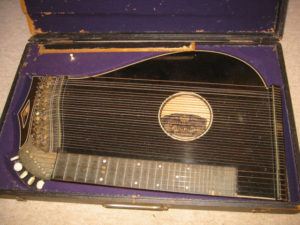
When my grandfather died, his nephew, who lived in Wisconsin, inherited his beloved zither.
We had some special moments, Ed and I.
He didn’t talk to me much, but now and then he would let me come into the garden and he would cut stalks of fragrant, red rhubarb for me. We would walk over to the compost, a deep pit dug perfectly square and surrounded by sweet-smelling grass clippings that he would sprinkle over the latest addition of kitchen scraps. Standing by this huge pit whose heat radiated up and warmed my face, Ed would cut up the poisonous rhubarb leaves, toss them in, and hand me the silky stalks, which I would eat right there, savoring their tart acidity the way most kids savored ice cream.
One day, he gave me a little golden ring, found, he said, in the garden. It was a tiny thing, 24-carat gold, and had an “M” engraved on its face. I wore it on my ring finger until it became too tight, and then I moved it to my little finger, turning it upside down to read “W,” because by then I had fallen in love with a beautiful Hawaiian boy named Wayne. Ed died a few years later and Wayne is dead now, too. I don’t know what happened to the little ring, but all it took was the aroma of rhubarb this morning and I could see every detail of it again, even feel the pinch of its broken band, though on my heart this time instead of the fleshy part of my little finger.
It was early this morning when I picked my rhubarb, thinking I would make a fresh batch of chutney and write a strictly cooking column for a change. I didn’t know when I leaned over and made that first cut into the crisp red stalk that memory would gallop away from me, a wild horse I’ve chased all morning, taking you along for the ride.




